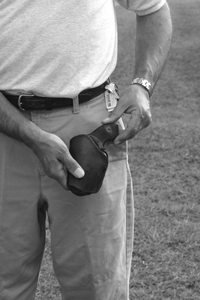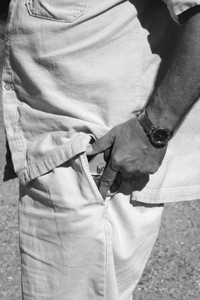
People have been carrying guns in their pockets ever since firearms became small enough to fit there.
Wild Bill Hickok carried one or more derringers in his pockets to back up his famous pair of 36-caliber cap ’n ball Navy Colts. Wyatt Earp testified under oath in re the deaths of Frank McLaury, William Clanton, and Thomas McLaury that he began the OK Corral shootout with his hand on the butt of a Colt Single Action Army 45 revolver in the pocket of his overcoat.

Colt’s in-house gun shark J.H. Fitzgerald made up a pair of heavy frame New Service 45 revolvers with stubbed barrels, and wore a pair of them in leather-lined side pockets in his trousers. He made up one of those guns for Col. Rex Applegate, who packed one in a hip pocket when he bodyguarded Franklin D. Roosevelt. Legendary Border Patrol gunslick Bill Jordan was partial to a bobbed-hammer Smith & Wesson Model 37 Airweight Chief Special 38 in a hip pocket for backup and sometimes off-duty wear.
On duty or off, famed NYPD Stakeout Squad gunfighter Jim Cirillo carried a hammer-shrouded 38 Colt Cobra snubby in a trouser pocket.
Today, in the 21st Century, we don’t have the baggy pants of the Depression Years that allowed “Fitz” to carry a big-frame 45 in each pocket. But, thanks to the caprices of the fashion world, we have billowy Dockers-style trousers and BDUs. We have light, powerful handguns only dreamt of in Fitzgerald’s time. And, perhaps most important, we have the finest pocket holsters that have ever existed.
The Pocket Itself
In the olden days, the pocket was the holster. The history of the Old West tells us that Luke Short carried his Colt Thunderer double-action 41 in a leather-lined hip pocket, and used that combination to outdraw and kill a gunman deemed much more dangerous than he, “Long-Haired Jim” Courtright. Famed lawman Dallas Stoudenmire carried a pair of short-barrel Smith & Wesson single action, top-break 44s in special pants, whose hip pockets he had likewise had lined with leather by an obliging tailor.
Today, the leather-lined pocket has gone the way of the dodo bird. However, reinforced pockets designed expressly for handguns remain. A company called Betz started the trend to jackets with hidden, built-in holsters. A Betz coat can carry a full-size service auto inside next to the breast.
It’s drawn in a fashion similar to what you’d use with a shoulder holster. The Royal Robbins 5.11 Tactical vest has built-in gun pockets of similar style. Our nation’s largest sheriff’s department, comprised of several thousand uniformed deputies, orders all their uniform jackets with a special inside pocket of this kind, cut for the J-frame S&W snub-nose 38 most of their sworn personnel carry for backup. Concealed Carry Clothiers has reinforced side pockets for small handguns in their line of vests made especially for CCW carriers.
Nor have pants pockets been neglected. For decades, the troopers of a certain state have been issued two handguns, one full size and one small. The full-size gun, of course, went in a uniform belt holster. The smaller was carried in a side trouser pocket: mandatory, no exceptions. The pants were ordered with one reinforced pocket from the uniform manufacturer.
Over the years, many a trooper in that state was saved by this little pants pocket hideout. Sometimes, it happened when someone got the primary gun away and the trooper had to resort to “Plan B.” Sometimes, it was just easier to approach a stopped car with the hand inconspicuously in the pocket and wrapped around the little 38.
When danger threatened, this made for a lightning fast draw and return of fire. Over the years that department went from the 38 Special as a primary service revolver, to the 357 Magnum, to the 9mm auto, to their currently issued 40-caliber service automatic. The backup has stayed pretty much the same: a small-frame Smith & Wesson revolver with short barrel. The current issue is the Model 640-1 “hammerless” 357 Magnum, loaded with +P+ Hydra-Shok 38 Special ammunition.
“Civilians” have not been neglected. Blackie Collins created special jeans for pistol-packers, appropriately called Toters. Both hip pockets and both side pockets are specially reinforced for carrying handguns. Since this is the very same Blackie Collins who first became famous as a knife designer, there’s also a special quick-access pocket for a tactical folder.
Pocket Holsters

Even by the time of the Old West gunfighters, it had become apparent that regular pockets by themselves weren’t enough to sustain the carrying of a defensive handgun. The pistol’s weight, and sometimes its sharp edges, would tear through pocket linings. A small handgun could change its orientation due to body movement through the day, and perhaps turn upside down in the pocket. The shape of the gun was likely to “print” through the fabric, betraying the “concealed” element of concealed carry.
The first pocket holsters were simply leather squares or rectangles with gun pouches sewn on, sometimes crudely. In modern times, the art and design of the pocket holster have been refined dramatically. In addition to leather, we now see them crafted of Kydex, nylon, and assorted other synthetics. Greg Kramer popularized a leather model with a flat Kydex square on the outside, which broke up the outline of the gun. With tight pants, someone might be able to see that you had something in your pocket, but they wouldn’t be able to tell that it was a firearm.
There are numerous fine pocket holsters available today. Manufacturers of same include Jerry Ahern, Lou Alessi, Gene DeSantis, Galco, Greg Kramer, Ky-Tac, Mach-2, Bob Mika, Milt Sparks, Mitch Rosen, Thad Rybka, Safariland, Uncle Mike’s, and more. I’ve used most of the above, with good success.
Personal favorites, for my own specific needs, have come down to three. With a snub-nose J-frame revolver, I’ve had the best luck with the Safariland. Designed by Bill Rogers, it’s made of synthetic Porvair on the inside and faux suede on the outside. The outer surface makes it stick to the pocket lining and yield the gun instead of coming out with it, no matter what the angle of draw; the smooth Porvair on the inside reduces friction and speeds the draw. Unfortunately, it seems to be made only for J-frame snubs at this writing. (Seems to wear hell out of the gun’s finish, too.)
For the baby Glock, I use either the Mach-2 or the Ky-Tac. Both are made of Kydex and are so close in design and function that they’re hard to tell apart. An almost curlicue flange at the top catches the upper edge of the pocket as you clear the square-shaped auto pistol, and a similar protrusion at the rear of the holster catches the bottom edge if you prefer to draw horizontally out of the pocket.
For most anything else – for instance, the neat little Kahr PM9 polymer-framed 9mm, a favorite pocket auto, or the 380 size Colt Pocket Nine – I prefer Greg Kramer’s classic pocket rig. Mike Dillon, who makes a point of putting only the best of everything in his Blue Press catalog, lists the Kramer pocket holster in those pages. It’s a hell of an endorsement, and when you work with a Kramer pocket rig, an understandable one.

Next Step: Get your FREE Printable Target Pack
Enhance your shooting precision with our 62 MOA Targets, perfect for rifles and handguns. Crafted in collaboration with Storm Tactical for accuracy and versatility.
Subscribe to the Gun Digest email newsletter and get your downloadable target pack sent straight to your inbox. Stay updated with the latest firearms info in the industry.

![Best Concealed Carry Guns In 2025 [Field Tested] Wilson Combat EDC X9S 1](https://gundigest.com/wp-content/uploads/Wilson-Combat-EDC-X9S-1-324x160.jpg)


![Best 9mm Carbine: Affordable PCCs [Tested] Ruger Carbine Shooting](https://gundigest.com/wp-content/uploads/Ruger-Carbine-Shooting-100x70.jpg)
![Best AR-15: Top Options Available Today [Field Tested] Harrington and Richardson PSA XM177E2 feature](https://gundigest.com/wp-content/uploads/Harrington-and-Richardson-PSA-XM177E2-feature-100x70.jpg)
